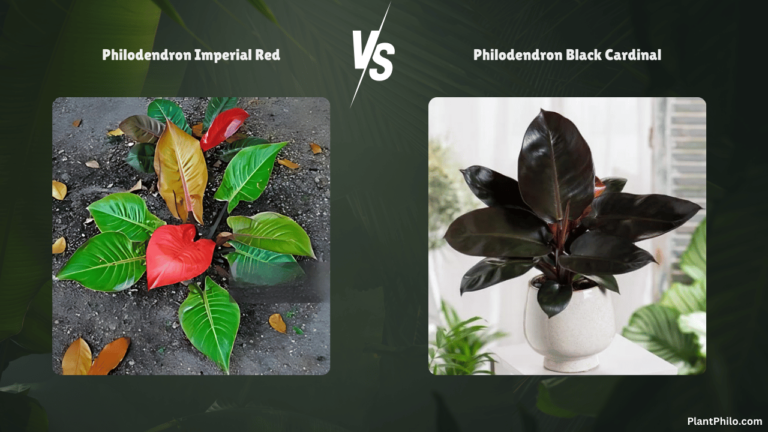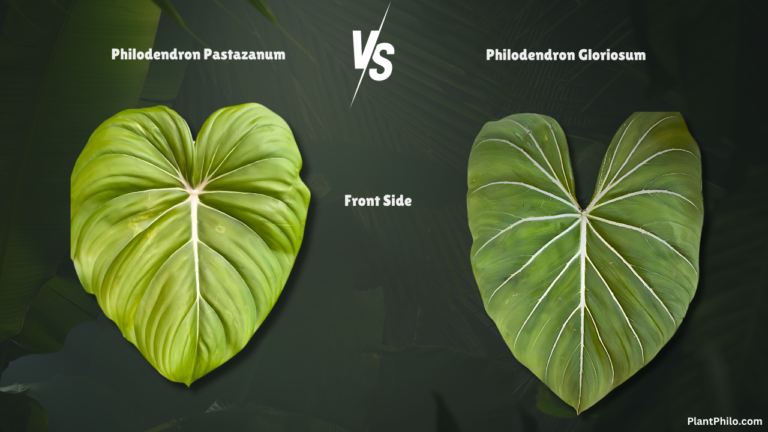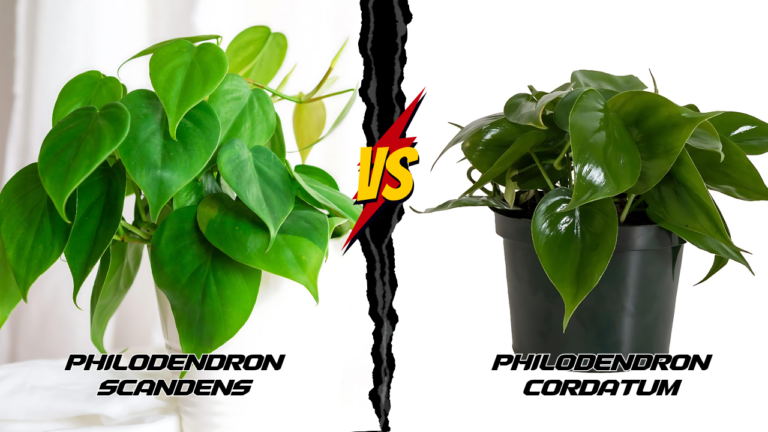Philodendron Joepii vs. 69686: Leaf Shape, Growth Habits, Care, Identification & More
Forget the basic begonias and pedestrian pothos – it’s time to level up your plant game with some rare and exotic foliage. Philodendron Joepii and 69686 are the cool kids on the block, but which one will you choose? Let’s take a closer look and find out which of these elusive beauties is the perfect match for your plant-parenting style.
Philodendron Joepii stands out with its elongated, dark green leaves, making it a striking presence in any houseplant collection. On the other hand, Philodendron 69686 features more heart-shaped leaves that are equally captivating but distinctly different in shape. Both plants are not easy to find, adding to their allure among plant enthusiasts.
Caring for these plants can be quite rewarding. Both Philodendron Joepii and 69686 require similar conditions, thriving best in humid environments with indirect light. Knowing the specific needs of each plant will help you decide which one to add to your collection. Experienced collectors often recommend starting with the plant that aligns best with your care preferences and living space.
Key Takeaways
- Joepii has elongated leaves; 69686 has heart-shaped leaves.
- Both plants need humid conditions and indirect light to thrive.
- Choose the plan that fits your care abilities and space.
Comparison Summary at A Glance
| Feature | Philodendron Joepii | Philodendron 69686 |
| Origin | French Guiana | Unknown (possibly Peru) |
| Rarity | More common | Rare |
| Price | Relatively Affordable | Can be more expensive |
| Leaf Shape | Long, narrow, deeply lobed with many holes | Broader, less deeply lobed |
| Leaf Size | 8-12 inches | Up to 18 inches or more |
| Leaf Texture | Smooth, slightly leathery | Smooth, slightly leathery |
| Leaf Color | Deep green, sometimes reddish/purple underneath | Deep green, sometimes with bluish tint |
| New Leaf Color | Lighter green, darkens with age | Coppery/bronze, turns green |
| Petiole (Leaf Stalk) | Shorter, thinner | Longer, sturdier |
| Growth Habit | Climbing, alternating leaf pattern | Can climb, but may be upright/bushy when young |
| Additional Notes | More common in the market | Often more challenging to find |
| Care Difficulty | Moderate | Slightly difficult |
Key Points to Remember:
- Leaf Shape: The most distinct visual difference lies in the leaf shape and fenestrations (holes). Joepii tends to have more holes and deeper lobes, while 69686 has broader leaves with less pronounced lobes.
- Leaf Size: While Joepii leaves are generally smaller, both plants can have larger leaves under optimal conditions.
- Color Variations: Be aware of the subtle differences in color, especially the reddish/purplish underside of Joepii leaves and the occasional bluish tint on 69686.
- Growth Habit: While both can climb, young 69686 plants might have a more upright growth pattern, whereas Joepii tends to vine early.
Background and Origins
Both Philodendron Joepii and Philodendron 69686 belong to the Philodendron genus, a large group of flowering plants within the Araceae family, each with unique characteristics that set them apart.
Philodendron Joepii
Philodendron Joepii hails from the lush Amazon rainforest, where Dutch botanist Joep Moonen first discovered it. The plant is known for its unusual and striking skeletal leaf structure, with deep lobes and holes. Its leaves can grow quite large, up to 1 meter in length, and it reaches heights of up to 4 meters.
Native to the tropical regions of Brazil, it thrives in humid conditions, adding a touch of exotic beauty to any plant collection. The plant also produces a large inflorescence—a structure housing many small flowers.
“The Joepii’s unique form really sets it apart. It’s something you don’t see often,” says one experienced collector.
Philodendron 69686
Philodendron 69686, also from the Philodendron genus, was discovered in French Guiana. It’s often identified by its heart-shaped leaves, which are subtly different from the Joepii’s strap-shaped leaves. Unlike the Joepii, this plant has more uniform leaf edges.
Known for its sprawling growth habit, Philodendron 69686 is often prized for its lower maintenance and propagation ease. It can be propagated using stem cuttings that include at least two joints, making it popular among plant enthusiasts.
“Philodendron 69686 is a gem for those who love unique but easy-to-care-for plants,” says an expert from Green Haven Plants.
Visual Comparison: Leaves
The Philodendron Joepii and 69686 have distinct visual differences, especially in their leaves. Understanding these key differences helps you identify and appreciate each plant’s unique characteristics.
Shape
The Philodendron Joepii often has tri-lobed leaves with an hourglass shape. These leaves are long and narrow, giving the plant a sleek look. In contrast, the Philodendron 69686 has heart-shaped leaves that are broader and more rounded. This gives it a more classic and fuller appearance.
Experienced collectors often note the Joepii’s unusual leaf shape as its standout feature. One collector stated, “I’ve never seen anything like Joepii’s leaf shape in any other plant.”
Size
The leaves of the Joepii can grow to impressive lengths, often reaching up to a meter long. This makes Joepii an attention-grabbing focal point in any plant collection. On the other hand, the leaves of the 69686 tend to be smaller, averaging around 30-40 centimeters in length. Though smaller, 69686 still makes a significant impact due to its dense foliage.
Gardeners love Joepii for its dramatic size, while 69686 is appreciated more for its compact yet lush presentation.
Texture
The texture of Joepii leaves is somewhat leathery and firm to the touch. This toughness contributes to the plant’s durability. In contrast, the leaves of 69686 feel smoother and somewhat softer, which can make handling them a different experience.
Many people enjoy the robust texture of Joepii. An expert once mentioned, “The leathery feel of Joepii’s leaves is what sets it apart.”
Color
Joepii’s coloration is generally a lighter green, which can add brightness to a plant collection. Conversely, 69686 has darker green leaves with a more uniform coloration. This darker shade can create a rich, lush look.
The color differences help distinguish the two plants at a glance. The lighter and darker hues each offer aesthetic appeal depending on your taste.
New Leaf Emergence
When new leaves emerge on the Joepii, they start as a light, almost pale green before maturing into their final shade. This transition phase can be quite striking. For 69686, new leaves start a bit darker and gradually reach their mature dark green, demonstrating a less noticeable color shift but still a change worth noting.
Collectors appreciate watching the color transitions in new leaves, as it adds a dynamic aspect to plant care.
Petioles (Leaf Stalks)
The petioles of Joepii are generally thicker and more robust, supporting its larger leaves. They are also slightly lighter in color compared to the rest of the plant. 69686 petioles are thinner yet sturdy, matching the heart-shaped leaves’ needs.
The difference in petiole size and sturdiness reflects each plant’s adaptation to its specific leaf structure, aiding in identification.
Growth Habit and Structure
Both Philodendron Joepii and 69686 have distinct growth habits and structures. These unique differences are crucial for plant enthusiasts trying to decide which species fits their home or garden environments better.
Joepii
Philodendron Joepii tends to grow upright and has thick, leathery leaves. The leaves can reach up to 1 meter long and are dark green. The plant is a strong climber, so you’ll often see its aerial roots clinging to supports or climbing structures.
This plant can grow up to 4 meters tall, making it quite impressive. Its stems are thick and robust, providing a sturdy structure that can support the large leaves and the beautiful inflorescence it produces.
As Sarah, an experienced collector, notes, “Joepii’s rough edges and strap-like leaves make it truly unique and eye-catching, perfect for any modern indoor jungle.”
69686
Philodendron 69686, in contrast, has a more sprawling growth habit. It produces heart-shaped leaves that are both distinct and charming. These leaves are generally more uniform in shape compared to Joepii’s irregular-edged leaves.
The stems of 69686 are slightly thinner and lighter green, making them different visually and structurally. It doesn’t climb as aggressively but still benefits from support structures when necessary.
For propagation, use stem cuttings with at least two joints, as noted on Green Haven Plants. This method ensures the extension and maintenance of this remarkable variety, making it easier to manage and grow.
As plant expert Tom remarked, “The 69686’s softer, sprawling nature makes it an excellent choice for those who prefer a less imposing, yet still striking, houseplant.”
Care Requirements
Taking care of Philodendron Joepii and Philodendron 69686 involves managing light, watering, humidity, temperature, and soil needs. They are fairly easy to look after with some specific needs.
Light
Both plants thrive in bright, indirect sunlight. Direct sunlight can scorch their leaves, so find a spot with plenty of filtered light. If natural light is scarce, consider using a grow light. Inadequate light can slow growth and dull leaf color.
Water
Keep the soil moist but not waterlogged. Water when the top inch of soil feels dry to the touch. Overwatering is a common problem, leading to root rot. Ensure you have a pot with drainage holes to prevent water from standing at the bottom.
Humidity
These plants prefer high humidity levels, ideally between 60% and 80%. Increase humidity with a humidifier or by placing a tray of water near the plant. Misting the leaves occasionally can also help avoid excessive moisture that might lead to fungal issues.
Temperature
Maintain a warm environment with temperatures ranging from 59°F to 90°F (15°C to 32°C). Avoid placing them in areas with cold drafts or sudden temperature fluctuations. Consistent warmth promotes healthier growth.
Soil
Use a well-draining potting mix that retains some moisture but does not become soggy. A mix of peat moss, perlite, and sphagnum moss works well. Good drainage ensures the roots don’t sit in water, which can cause diseases.
pH Level
Philodendrons prefer a slightly acidic to neutral pH level, around 5.5 to 7.0. Test your soil’s pH periodically to ensure it remains within this range. You can adjust pH with appropriate soil amendments if necessary.
Support
Philodendron Joepii, in particular, may require support due to its large size. Use a moss pole or a sturdy stake to support the stems. This not only helps maintain an upright growth habit but also ensures better air circulation around the plant.
Fertilizer
Feed both plants with a balanced fertilizer once a month during the growing season (spring and summer). A liquid fertilizer diluted to half strength works well. Avoid fertilizing in the colder months when the plant’s growth slows down.
Additional Differentiating Factors
Rarity and Price
Philodendron Joepii is rare but generally more common and affordable compared to the even more expensive Philodendron 69686. Collectors often pay a premium for the 69686 due to its scarcity.
Leaf Shape Variations
Both plants show significant variation in leaf shape. Joepii has long, strap-shaped leaves with irregular edges, while 69686 has heart-shaped leaves with a uniform look. Sometimes, variations make it tricky to tell them apart without close inspection.
Genetic Testing
If you ever get confused about your plant’s identity, remember that the only foolproof way to confirm its species is through genetic testing. This can be especially important for serious collectors.
Availability
Philodendron Joepii might be easier to find in the market. However, 69686 is considered a collector’s gem. You can mostly get it through specialized plant nurseries or plant collectors willing to part with this rare treasure.
Common Issues
Both plants can face issues like yellowing leaves due to overwatering or insufficient light. Proper care is crucial to keep them thriving. Always check for pests and maintain good watering habits.
Identifying Characteristics
- Philodendron Joepii: Long, strap-shaped leaves, dark green, named after Dutch botanist Joep Moonen.
- Philodendron 69686: Heart-shaped, uniform leaves, more difficult to find.
Quotes from plant enthusiasts highlight the love they have for these unique varieties. One collector mentioned, “The Joepii is a staple in my collection, but finding a 69686 was like finding gold!”
Check out more about Joepii Philodendron and Philodendron 69686 Care Guide for additional details.
Choosing the Right Plant for You
When deciding between the Philodendron Joepii and 69686, there are a few things you should think about.
Availability and Budget
Philodendron Joepii might be easier to find and more affordable. As one expert notes, “Joepii plants are often less costly than the rarer 69686 variety.”
Personal Preference
Look at the leaf shape and growth habit. Joepii has thicker, more upright stems, while 69686 tends to be more sprawling. If you prefer a bushy look, 69686 might be your choice.
Growing Experience
Both plants need similar care, such as bright, indirect light and well-draining soil. However, 69686 can be a bit more finicky. One collector mentions, “69686 requires a bit more attention, especially in humidity needs.”
Care Tips
- Light: Bright, indirect light.
- Soil: Well-draining mix.
- Watering: Water when the top inch is dry.
Pros and Cons
| Joepii | 69686 | |
| Availability | More common | Rare |
| Cost | Less expensive | More expensive |
| Care Difficulty | Moderate | Slightly difficult |
Choose based on what you prefer and what fits best with your care abilities.
Frequently Asked Questions
Philodendron Joepii and 69686 have unique features, care requirements, and growth patterns. Here we answer some common questions to help you understand these beautiful plants better.
What are the care requirements for Philodendron 69686 compared to Joepii?
Philodendron 69686 thrives in well-draining soil composed of sand and peat moss. It prefers bright, indirect light and should be watered when the top inch of soil is dry.
Philodendron Joepii needs similar care but is more tolerant of direct sunlight. Both plants benefit from humidity and regular feeding during the growing season.
Which is more rare, Philodendron Joepii or 69686, and why?
Philodendron Joepii is generally considered more rare. It is native to the Amazon rainforest and is prized for its unique leaf shape and growth habit.
Philodendron 69686 is rare, too, but is more commonly available in plant shops and online stores.
How do Philodendron Joepii and 69686 differ in their growth habits?
Philodendron Joepii tends to grow upright and can reach up to 4 meters in height. It has thick, leathery leaves.
Philodendron 69686, on the other hand, has a more sprawling growth habit. It can cover more ground with its heart-shaped leaves and typically requires support as it grows.
Why does Philodendron 69686 have its specific name, and what’s its origin?
Philodendron 69686 doesn’t have a common name, which is why it’s referred to by its catalog or specimen number.
This number helps botanists and collectors identify the plant easily. The specific number often reflects the plant’s entry in a scientific database or collection.
Can you provide tips on propagating Philodendron 69686 versus Joepii?
Propagating Philodendron 69686 is straightforward. Use stem cuttings with at least two joints and place them in well-draining soil. Keep the soil moist but not waterlogged.
Philodendron Joepii can be propagated in a similar way. Make sure the cuttings have a few leaves and roots. They can be placed in water first until roots develop, then moved to soil.
What are the visual distinctions between Philodendron Joepii and 69686?
Philodendron Joepii has elongated, dark green leaves that can grow up to 1 meter long. The plant also has a more upright growth habit.
Philodendron 69686 features heart-shaped leaves that are lighter in color. Its stems are thinner and tend to sprawl rather than grow upright.



